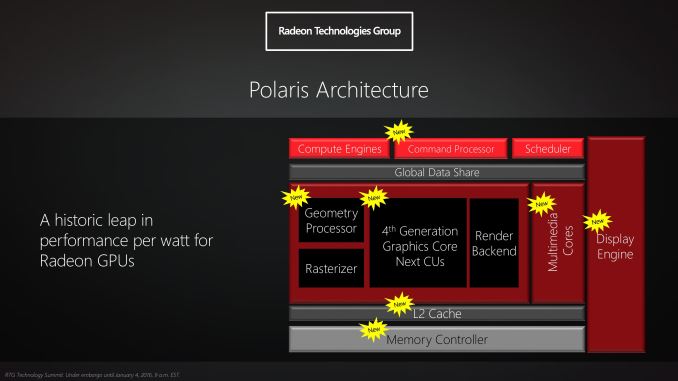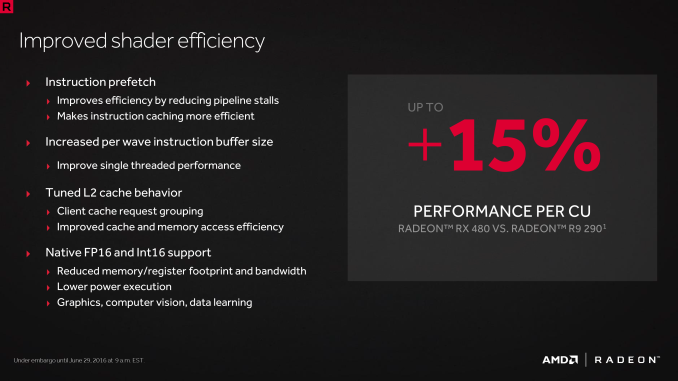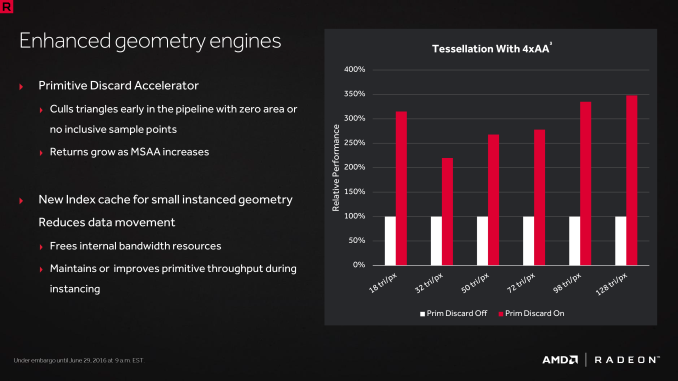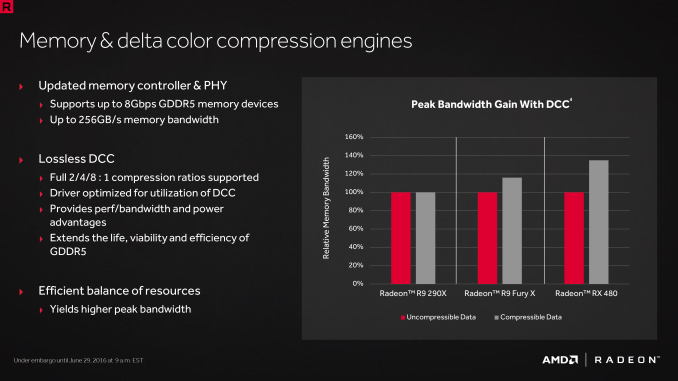The AMD Radeon RX 480 Preview: Polaris Makes Its Mainstream Mark
by Ryan Smith on June 29, 2016 9:00 AM ESTThe Polaris Architecture: In Brief
For today’s preview I’m going to quickly hit the highlights of the Polaris architecture.
In their announcement of the architecture this year, AMD laid out a basic overview of what components of the GPU would see major updates with Polaris. Polaris is not a complete overhaul of past AMD designs, but AMD has combined targeted performance upgrades with a chip-wide energy efficiency upgrade. As a result Polaris is a mix of old and new, and a lot more efficient in the process.
At its heart, Polaris is based on AMD’s 4th generation Graphics Core Next architecture (GCN 4). GCN 4 is not significantly different than GCN 1.2 (Tonga/Fiji), and in fact GCN 4’s ISA is identical to that of GCN 1.2’s. So everything we see here today comes not from broad, architectural changes, but from low-level microarchitectural changes that improve how instructions execute under the hood.
Overall AMD is claiming that GCN 4 (via RX 480) offers a 15% improvement in shader efficiency over GCN 1.1 (R9 290). This comes from two changes; instruction prefetching and a larger instruction buffer. In the case of the former, GCN 4 can, with the driver’s assistance, attempt to pre-fetch future instructions, something GCN 1.x could not do. When done correctly, this reduces/eliminates the need for a wave to stall to wait on an instruction fetch, keeping the CU fed and active more often. Meanwhile the per-wave instruction buffer (which is separate from the register file) has been increased from 12 DWORDs to 16 DWORDs, allowing more instructions to be buffered and, according to AMD, improving single-threaded performance.
Outside of the shader cores themselves, AMD has also made enhancements to the graphics front-end for Polaris. AMD’s latest architecture integrates what AMD calls a Primative Discard Accelerator. True to its name, the job of the discard accelerator is to remove (cull) triangles that are too small to be used, and to do so early enough in the rendering pipeline that the rest of the GPU is spared from having to deal with these unnecessary triangles. Degenerate triangles are culled before they even hit the vertex shader, while small triangles culled a bit later, after the vertex shader but before they hit the rasterizer. There’s no visual quality impact to this (only triangles that can’t be seen/rendered are culled), and as claimed by AMD, the benefits of the discard accelerator increase with MSAA levels, as MSAA otherwise exacerbates the small triangle problem.
Along these lines, Polaris also implements a new index cache, again meant to improve geometry performance. The index cache is designed specifically to accelerate geometry instancing performance, allowing small instanced geometry to stay close by in the cache, avoiding the power and bandwidth costs of shuffling this data around to other caches and VRAM.
Finally, at the back-end of the GPU, the ROP/L2/Memory controller partitions have also received their own updates. Chief among these is that Polaris implements the next generation of AMD’s delta color compression technology, which uses pattern matching to reduce the size and resulting memory bandwidth needs of frame buffers and render targets. As a result of this compression, color compression results in a de facto increase in available memory bandwidth and decrease in power consumption, at least so long as buffer is compressible. With Polaris, AMD supports a larger pattern library to better compress more buffers more often, improving on GCN 1.2 color compression by around 17%.
Otherwise we’ve already covered the increased L2 cache size, which is now at 2MB. Paired with this is AMD’s latest generation memory controller, which can now officially go to 8Gbps, and even a bit more than that when oveclocking.














449 Comments
View All Comments
AntDX316 - Thursday, June 30, 2016 - link
Still slower and less efficient than NVidia's offerings.If only.. AMD just sold all their assets to nvidia and intel, the advancement of technology would be insane. But, if the investors/CEOs decide to insane price gouge and money milk they would have full control of that. They would be like some of the pharmaceutical companies who charge so much. I think they do that in the beginning so when the other companies make a cheaper version that works they can lower their price yet keep ALL the gains from the beginning.
fanofanand - Thursday, June 30, 2016 - link
Your economic understanding could use a bit of improvement. Pharmaceutical companies are in the position to price gouge because they are often patent holders of life saving drugs. The day an RX480 saves someone's life (beyond metaphorically speaking) your argument will have merit. Nvidia dropping the price of the 970 as this card was released speaks volumes about the free market and competition being a necessity. Nobody will die without the 480 or 970. AMD selling to Intel and NVidia would essentially leave both of those companies without competition. If you don't see that as a doomsday scenario for the PC Master Race......Ghiacciori - Wednesday, June 29, 2016 - link
The big marketing trick AMD used in Polaris release was that their 480CF could beat the GTX 1080 for 400usd (seems like they were talking about the 4GB version). Seeing a single 480 can put up a good fight against the 970, it's clear the 480CF setup could never be up to the task of outperforming the 1080. Now, the real fight would be the 480CF vs GTX 1070, and considering their price tag, the CF (I'm talking 8gigs version here) not only would be more expensive than a single GTX 1070 but it'd also have twice its power draw... So, I doesn't look like a good deal to me, even assuming multi-gpu gets more support in new titles, which, if experience has something to say, seems unlikely.Now, whether or not this card in a single-gpu rig is a good choice or not... Now, it is since it's cheaper than the 970. However, nVidia still has to release their GTX 1060, and IF it has the same 1070/970 performance and consumption ratio, the GTX 1060 could be a better option than 480 depending on price tag.
bigjoe980 - Wednesday, June 29, 2016 - link
hmm, if the Hardwareunboxed crossfire test is accurate, it'll at least have a good leg to stand on...but of course, that's only provided the results weren't fudged at all.... *shrug*Flunk - Wednesday, June 29, 2016 - link
SLI GTX 970s do actually beat the GTX 1080... In 3Dmark and basically nowhere else.Ghiacciori - Wednesday, June 29, 2016 - link
Just saw the CF results, not just in Hardwareunboxed but in techpowerup as well... They're impressive and look very promising. Still, optimization continues to be an issue with a lot of games not taking advantage of the second gpu.amitp05 - Thursday, June 30, 2016 - link
They didn't say 480CF will be $400. They said 2 480CF will be <$500 and beat the 1080 ($650).Clever statement cover both 4 and 8GB cards.
FriendlyUser - Wednesday, June 29, 2016 - link
Thanks for the review! Good job.Please post crossfire, trifire and quadfire results. I wonder how it scales.
mdriftmeyer - Wednesday, June 29, 2016 - link
I'll take two of these, enjoy working in Solid Modeling enabled OpenCL apps, FEA/FEM and CFD, while screaming through apps that crunch heavily on OpenCL and can work with the HDR and more. Encoding in H.265 via hardware will be a joy.Dual 8GB pipelines for $30 more than a 1070 FE, and you children call it a bust? Nvidia blew their market lead and the next two quarters will show it. AMD's financial statements will back up the volume sales and bring the company back into the black.
BrokenCrayons - Wednesday, June 29, 2016 - link
It's a bit early to forecast the financial performance of the company in the future. We're only seeing a single GPU product's performance at the moment and the competition hasn't yet responded. I'd certainly like to see AMD do better because I benefit as a consumer from them remaining a concern for Intel and NV.Besides the monetary aspects, there's a lot to like about the 480. It's got lots of VRAM, performs pretty well, and the price looks reasonable. However, I'm disappointed by the power consumption. My expectations were probably unrealistic given the forces driving the industry, but I was really hoping for more power savings. I miss high end graphics cards that were powered by the bus they were installed in and fit in a single slot.